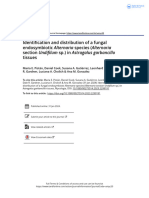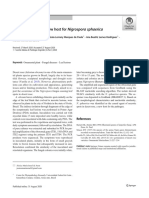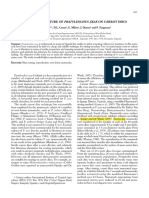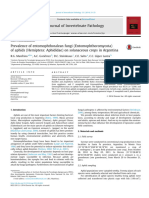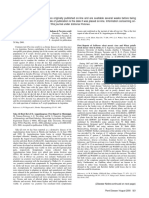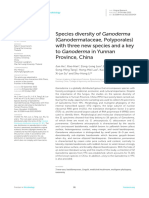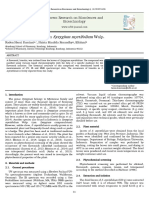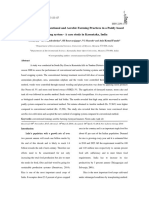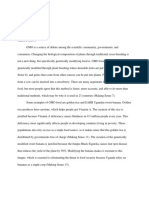Professional Documents
Culture Documents
First Record of Monographella Albescens On Rice in PDF
Uploaded by
Martinius TinOriginal Title
Copyright
Available Formats
Share this document
Did you find this document useful?
Is this content inappropriate?
Report this DocumentCopyright:
Available Formats
First Record of Monographella Albescens On Rice in PDF
Uploaded by
Martinius TinCopyright:
Available Formats
See discussions, stats, and author profiles for this publication at: https://www.researchgate.
net/publication/237115723
First record of Monographella albescens on rice in Corrientes Province,
Argentina
Article in Australasian Plant Disease Notes · December 2007
DOI: 10.1071/DN07008
CITATIONS READS
3 922
3 authors, including:
Sara Guti Erlei Melo Reis
Novartis Universidade de Passo Fundo
1 PUBLICATION 3 CITATIONS 209 PUBLICATIONS 1,570 CITATIONS
SEE PROFILE SEE PROFILE
Some of the authors of this publication are also working on these related projects:
Selecting Glomus species for soybean seed inoculaation. View project
Exserohilum turcicum en maíz: caracterización morfológica y patológica, asociación a semillas y sensibilidad a fungicidas. - Exserohilum turcicum in
corn:morphological and pathological characterization, seeds association and fungicide sensibility View project
All content following this page was uploaded by Erlei Melo Reis on 04 January 2015.
The user has requested enhancement of the downloaded file.
CSIRO PUBLISHING
www.publish.csiro.au/journals/apdn Australasian Plant Disease Notes, 2007, 2, 19–20
First record of Monographella albescens on rice in Corrientes
Province, Argentina
S. A. GutiérrezA,D , E. M. ReisB and M. A. CarmonaC
A
Cátedra de Fitopatologı́a, Facultad de Ciencias Agrarias, Universidad Nacional del Nordeste,
Sargento Cabral 2131 (3400), Corrientes, Argentina.
B
Fitopatologı́a, Facultade de Agronomia e Veterinaria, UPF, Cx. Postal 611, 99001-970, Passo Fundo, Brasil.
C
Fitopatologı́a, Facultad de Agronomia, Universidad de Buenos Aires, Av. San Martı́n 4453 (1417),
Ciudad de Buenos Aires, Argentina.
D
Corresponding author. Email: suarroz@yahoo.com.ar
Abstract. Monographella albescens (teleomorph) is recorded for the first time on leaves of rice in Corrientes Province,
Argentina.
Rice (Oryza sativa) is an important crop in Corrientes 12.5–20 × 3–3.7 µm (Fig. 3). The morphological features agree
Province, Argentina. Leaf scald of rice is a disease of with those given by other authors (Ou et al.1978; Boratynski
increasing importance in rice crops (Mazzanti de Castañón 1979; Parkinson et al. 1981).
and Gutiérrez 2001). The disease is characterised by zonate
lesions with alternating light tan to dark brown bands that
dry out giving leaves and foliar sheaths a scalded appearance
(Fig. 1). The disease is caused by the fungus Monographella
albescens (Thüm.) V.O. Parkinson, Sivan. & C. Booth (synonym
Metasphaeria albescens Thüm.) which is usually detected in
infected tissue in its anamorphic stage, Microdochium oryzae
(Hashioka and Yokogi) Samuels & I.C. Hallet (synonyms
Gerlachia oryzae (Hashioka and Yokogi) W. Gams and
Rhynchosporium oryzae Hashioka and Yokogi). In the two
rice crops grown during 2004–06 in Corrientes Province,
the sexual stage of the fungus, Monographella albescens,
was detected.
Leaves with leaf scald symptoms were colleted from
rice field crops in the localities of Itá Ibaté, Mercedes,
Santo Tomé and Virasoro (Corrientes Province, Argentina).
The infected samples were from the rice varieties Taim,
CT 6919, IRGA 417, Supremo 1 and Supremo 13. The
specimens were incubated in a moist chamber and infected
pieces of leaves were plated onto potato-glucose agar (PGA)
and bean agar. Morphometric and cultural features of the
causal agent were studied. The isolates were placed in the
fungal collection of the Laboratory of Plant Pathology, Faculty
of Agronomy, University of North East-Corrientes Province,
Argentina.
Perithecia of M. albescens were found in the green and
senescent leaves of rice crops close to ripening. In the
diseased tissues, the fungus develops light brown subepidermal
perithecia, which become dark brown when mature (Fig. 2). The
perithecia were globose, compressed, dark brown and measuring
137.5–167.5 × 87.5–120 µm; asci were cylindrical, hyaline and
tapered at both ends, with eight yellowish hyaline, slightly
curved oblong ascospores with three to four septate, measuring Fig. 1. Symptoms of leaf scald.
© Australasian Plant Pathology Society 2007 10.1071/DN07008 1833-928X/07/010019
20 Australasian Plant Disease Notes S. A. Gutiérrez et al.
Fig. 3. Asci and ascospores of Monographella albescens. Scale
bar = 20 µm.
Fig. 2. Perithecia of Monographella albescens on leaves of rice.
the pathogen and to generate fungal variability. Is important to
After 10 days on PGA, the fungus developed a whitish cotton- evaluate the potential role of seed borne Microdochium oryzae as
like colony with creamy-like salmon-pink masses corresponding primary inoculum for field epidemics, and to evaluate fungicide
to the conidial stage M. oryzae. The perithecia did not mature. seed treatments.
Leaf scald disease of rice occurs worldwide; it has been
reported in Africa, Asia and the USA. In Latin America it References
can be found in Costa Rica, El Salvador, Guatemala, Brazil
Boratynski TN (1979) La escaldadura de la hoja de arroz Rhynchosporium
and Argentina (Boratynski 1979; Webster and Gunnell 1992; oryzae Hashioka e Ikegami, en Costa Rica. Agronomia Costarricense 3,
Mazzanti de Castañón and Gutiérrez 2001). Rice seed is the 21–27.
major source of inoculum (Webster and Gunnell 1992). In Costa Gutiérrez SA (2002) Micoflora asociada al manchado del grano de arroz, XI
Rica, the teleomorph is also considered an important source Jornadas Fitosanitarias Argentinas, Rı́o Cuarto, Córdoba, 29.
of inoculum as well as contaminated seeds and crop stubble Mazzanti de Castañón MA, Gutiérrez SA (2001) Enfermedades del cultivo
(Boratynski 1979). del arroz en Argentina. Fitopatologia Brasileira 26, 471 [supplement].
In Argentina, Microdochium oryzae is the most frequent stage Ou H, Nuque FL, Vergel de Dios TI (1978) Perfect stage of Rhynchosporium
seen in field crops. The symptoms are often seen in leaves close to oryzae and the symptoms of leaf scald disease. Plant Disease Reporter
the soil towards the end of the tillering stage. Symptoms continue 62, 524–528.
Parkinson VO, Sivanesan A, Booth C (1981) The perfect state of the rice leaf
to develop until the panicle emerges, which is when the fungus
scald fungus and the taxonomy of both the perfect and imperfect states.
infects the rice grain (Mazzanti de Castañón and Gutiérrez Transactions of the British Mycological Society 76, 59–69.
2001; Gutiérrez 2002). The teleomorph is detected only in the Webster RK, Gunnell PS (1992) ‘Compendium of rice diseases.’ (The
senescent leaves or the leaves that are still green in the ripening American Phytopathological Society: St. Paul, MN)
stages of the crop. This is the first report of Monographella
albescens in Argentina. The role that Monographella albescens
plays in the epidemiology of rice scald in Argentina is not known.
The sexual stage may provide another source of dissemination of Manuscript received 6 November 2006, accepted 19 January 2007
http://www.publish.csiro.au/journals/apdn
View publication stats
You might also like
- Detection and Transmission Ofmicrodochium Oryzae From Rice Seed in ArgentinaDocument4 pagesDetection and Transmission Ofmicrodochium Oryzae From Rice Seed in ArgentinaMartinius TinNo ratings yet
- Enfermedades Bacterianas de Eucaliptos Estado ActuDocument10 pagesEnfermedades Bacterianas de Eucaliptos Estado ActuVictor Eranio RuizNo ratings yet
- Crop Protection: Sergine Ngatat, R. Hanna, P.L. Kumar, S.M. Gray, M. Cilia, R.T. Ghogomu, D.A. FontemDocument7 pagesCrop Protection: Sergine Ngatat, R. Hanna, P.L. Kumar, S.M. Gray, M. Cilia, R.T. Ghogomu, D.A. FontemPuta 1.47No ratings yet
- 108-Alternaria in Astragalus Garbancillo Tissues-2024Document9 pages108-Alternaria in Astragalus Garbancillo Tissues-2024anitama39No ratings yet
- Co Occurrence of Pathogenic and NonDocument10 pagesCo Occurrence of Pathogenic and NonmArA RodriguesNo ratings yet
- Bremia Lactucae GERBERADocument3 pagesBremia Lactucae GERBERARafael MejiasNo ratings yet
- 1 s2.0 S1658077X21001260 MainDocument10 pages1 s2.0 S1658077X21001260 MainAmanda De LorenziNo ratings yet
- Abstracts: Society of NematologistsDocument39 pagesAbstracts: Society of NematologistsFilani AyomideNo ratings yet
- MicrobiologíaDocument7 pagesMicrobiologíaymgmNo ratings yet
- Sub Angui en Pasto GolfDocument6 pagesSub Angui en Pasto GolfEdgar Medina GomezNo ratings yet
- Bemisia Tabaci, A Vector of Virus DiseasesDocument13 pagesBemisia Tabaci, A Vector of Virus DiseasesDavid Alberquerqui MachvielisNo ratings yet
- Diversity of Plant Parasitic Nematodes Associated With Rhizosphere of Maize From Different Areas of District Rajouri, Jammu and Kashmir, IndiaDocument4 pagesDiversity of Plant Parasitic Nematodes Associated With Rhizosphere of Maize From Different Areas of District Rajouri, Jammu and Kashmir, IndiaAmjad ShahzadNo ratings yet
- In Vitro Propagation of Cordia Verbenacea L. (Boraginaceae) : Lameira, O. A. Pinto, J. E. B. PDocument3 pagesIn Vitro Propagation of Cordia Verbenacea L. (Boraginaceae) : Lameira, O. A. Pinto, J. E. B. PHabibullah KhanNo ratings yet
- Phymatotrichum (Cotton) Root Rot Caused by Phymatotrichopsis OmnivoraDocument10 pagesPhymatotrichum (Cotton) Root Rot Caused by Phymatotrichopsis OmnivoraM.C. BRAULIO ALBERTO LEMUS SORIANONo ratings yet
- Triprophic RelationsDocument9 pagesTriprophic RelationsLuciana BarbozaNo ratings yet
- A Report of Meloidogyne Arenaria Parasitizing Plantain (Musa SPP., AAB) in NigeriaDocument4 pagesA Report of Meloidogyne Arenaria Parasitizing Plantain (Musa SPP., AAB) in NigeriaOlajide Emmanuel OlorunfemiNo ratings yet
- C. V. Toledo y C. Barroetaveña - Caracterización Miceliar de Hongos Silvestres ComestiblesDocument12 pagesC. V. Toledo y C. Barroetaveña - Caracterización Miceliar de Hongos Silvestres ComestiblesNicolas Ignacio Aliaga MachucaNo ratings yet
- Emma - Pdis 06 22 1350 SCDocument3 pagesEmma - Pdis 06 22 1350 SCOlajide Emmanuel OlorunfemiNo ratings yet
- Bacterial Diseases of Bananas and Enset Current State of Knowledge and Integrated Approaches Toward Sustainable ManagementDocument25 pagesBacterial Diseases of Bananas and Enset Current State of Knowledge and Integrated Approaches Toward Sustainable ManagementTheresa Anne MatunanNo ratings yet
- Bacterial Diseases Rice 2015Document13 pagesBacterial Diseases Rice 2015Teguh PratamaNo ratings yet
- Jesus2020 Article AdeniumObesumANewHostForNigros PDFDocument1 pageJesus2020 Article AdeniumObesumANewHostForNigros PDFmonkey luffyNo ratings yet
- 1997 WS IPM Bhowmik 45 349 356Document9 pages1997 WS IPM Bhowmik 45 349 356dadssdadasNo ratings yet
- The Resistance Test of 10 Rice Plant of Banten Local Variety To The Bacterial Leaf Blight Disease (Xanthomonas Oryzae Pv. Oryzae) Seedling PhaseDocument7 pagesThe Resistance Test of 10 Rice Plant of Banten Local Variety To The Bacterial Leaf Blight Disease (Xanthomonas Oryzae Pv. Oryzae) Seedling PhasengajialipNo ratings yet
- Efficacy of Different Bio-Control Agents Against Root-Knot NematodeDocument2 pagesEfficacy of Different Bio-Control Agents Against Root-Knot NematodeJournal of Environment and Bio-SciencesNo ratings yet
- Arachnitis Uni Ora: First Report of Corsiaceae For The Peruvian FloraDocument6 pagesArachnitis Uni Ora: First Report of Corsiaceae For The Peruvian FloraJose Franco NaviaNo ratings yet
- Pseudoperonosporareview PDFDocument39 pagesPseudoperonosporareview PDFRosangela Basualdo ChavezNo ratings yet
- Pythium GraminicolaDocument9 pagesPythium GraminicolaDaniel VilasecoNo ratings yet
- Monoxenic Culture of Pratylenchus Zeae On Carrot DiscsDocument2 pagesMonoxenic Culture of Pratylenchus Zeae On Carrot DiscsFernanda gNo ratings yet
- 22 PDFDocument6 pages22 PDFParishay BatoolNo ratings yet
- Manfrino Et Al 2014 - JIP 1Document3 pagesManfrino Et Al 2014 - JIP 1Claudia Lopez LastraNo ratings yet
- Rapid Culture of Pratylenchus Zeae On Carrot DiscsDocument2 pagesRapid Culture of Pratylenchus Zeae On Carrot DiscsFrank KagodaNo ratings yet
- Kamle 2013Document3 pagesKamle 2013Sheila MalpicaNo ratings yet
- Tmp289a TMPDocument4 pagesTmp289a TMPFrontiersNo ratings yet
- The Current Status of Root Diseases of Acacia Mangium WilldDocument9 pagesThe Current Status of Root Diseases of Acacia Mangium WilldSimona CeraselaNo ratings yet
- Xanthomonas Oryzae Pv. Oryzae: Bacterial Blight of RiceDocument3 pagesXanthomonas Oryzae Pv. Oryzae: Bacterial Blight of RiceIrvan MahmudiNo ratings yet
- 413 Ijar-19602Document7 pages413 Ijar-19602Cedrus CedrusNo ratings yet
- Characterization of The Heterokaryotic and Vegetative Diploid Phases ofDocument19 pagesCharacterization of The Heterokaryotic and Vegetative Diploid Phases ofIvan Sequera GrappinNo ratings yet
- Manfrinoetal-2016 PMSDocument7 pagesManfrinoetal-2016 PMSClaudia Lopez LastraNo ratings yet
- Poster SIPaV - 3547-2821-1-PBDocument32 pagesPoster SIPaV - 3547-2821-1-PBPietro Lo CantoreNo ratings yet
- Antagonistic Activity of A Bacillus SP Strain Isolated - 2017 - Revista ArgentiDocument2 pagesAntagonistic Activity of A Bacillus SP Strain Isolated - 2017 - Revista ArgentiNazario HuarachiNo ratings yet
- Thesis 2020Document112 pagesThesis 2020komal soniNo ratings yet
- Maize Northern Leaf Blight 226Document2 pagesMaize Northern Leaf Blight 226Shaik Gouse BashaNo ratings yet
- Assessment of Genetic Diversity in PeruvianDocument10 pagesAssessment of Genetic Diversity in PeruvianEyasuNo ratings yet
- Endophytic Fungi: Diversity, Abundance, and Plant Growth-Promoting AttributesDocument39 pagesEndophytic Fungi: Diversity, Abundance, and Plant Growth-Promoting AttributesAnonymous 9xXl8wmBNo ratings yet
- ZAKRIA Et Al-2008-Soil Science & Plant Nutrition PDFDocument13 pagesZAKRIA Et Al-2008-Soil Science & Plant Nutrition PDFJhon ReyesNo ratings yet
- This Content Downloaded From 150.161.240.235 On Fri, 13 Dec 2019 17:54:40 UTCDocument5 pagesThis Content Downloaded From 150.161.240.235 On Fri, 13 Dec 2019 17:54:40 UTCFrancione GomesNo ratings yet
- Cercospora Cf. Nicotianae Is A Causal Agent of Cercospora Leaf Blight of SoybeanDocument5 pagesCercospora Cf. Nicotianae Is A Causal Agent of Cercospora Leaf Blight of SoybeanWendy SerraNo ratings yet
- Microbiological Research: Silvana Díaz Herrera, Cecilia Grossi, Myriam Zawoznik, María Daniela GroppaDocument7 pagesMicrobiological Research: Silvana Díaz Herrera, Cecilia Grossi, Myriam Zawoznik, María Daniela GroppaJorge CorderoNo ratings yet
- 10 1016@j Flora 2019 151528Document36 pages10 1016@j Flora 2019 151528oscardckotsNo ratings yet
- The Resistance Test of 10 Rice Plant of Banten Local Variety To The Bacterial Leaf Blight Disease (Xanthomonas Oryzae Pv. Oryzae) Seedling Phase OlehDocument7 pagesThe Resistance Test of 10 Rice Plant of Banten Local Variety To The Bacterial Leaf Blight Disease (Xanthomonas Oryzae Pv. Oryzae) Seedling Phase OlehAmel RahmaNo ratings yet
- Plant Pathology - 2021 - Balocchi - Pewenomyces Kutranfy Gen Nov Et SP Nov Causal Agent of An Important Canker DiseaseDocument17 pagesPlant Pathology - 2021 - Balocchi - Pewenomyces Kutranfy Gen Nov Et SP Nov Causal Agent of An Important Canker DiseaseDaniela MartinezNo ratings yet
- Grapevine Trunk Diseases: Complex and Still Poorly UnderstoodDocument23 pagesGrapevine Trunk Diseases: Complex and Still Poorly UnderstoodzuilinhaNo ratings yet
- Population Genomics of The Neotropical Brown Stink Bug, Euschistus Heros The Most Important Emerging Insect Pest To Soybean in BrazilDocument12 pagesPopulation Genomics of The Neotropical Brown Stink Bug, Euschistus Heros The Most Important Emerging Insect Pest To Soybean in BrazilElizete CavalcanteNo ratings yet
- Crop Improvement in Lupinus MutabilisDocument7 pagesCrop Improvement in Lupinus MutabilispepeNo ratings yet
- PR Draft 2Document39 pagesPR Draft 2Hannie QuejanoNo ratings yet
- No Rs Worthy 2003Document8 pagesNo Rs Worthy 2003saman rasulNo ratings yet
- Fmicb 13 1035434Document18 pagesFmicb 13 1035434mercespatekNo ratings yet
- Green Peach Aphid On Vegetables: by Tom Kuhar, Sara Reiter and Hélène DoughtyDocument3 pagesGreen Peach Aphid On Vegetables: by Tom Kuhar, Sara Reiter and Hélène DoughtyuserNo ratings yet
- Jee96 0914Document11 pagesJee96 0914Aimer GuzmanNo ratings yet
- Luteolin, A Flavonoid From Syzygium Myrtifolium Walp.Document3 pagesLuteolin, A Flavonoid From Syzygium Myrtifolium Walp.Martinius TinNo ratings yet
- 116-Article Text-370-2-10-20221103 Pucuk MerahDocument6 pages116-Article Text-370-2-10-20221103 Pucuk MerahMartinius TinNo ratings yet
- Detection of Colletotrichum Lindemuthianum in Phaseolus Vulgaris (Bean) SeedDocument6 pagesDetection of Colletotrichum Lindemuthianum in Phaseolus Vulgaris (Bean) SeedMartinius TinNo ratings yet
- Detection of Pyricularia Oryzae in Oryza Sativa (Rice) SeedDocument6 pagesDetection of Pyricularia Oryzae in Oryza Sativa (Rice) SeedMartinius TinNo ratings yet
- Bio Priming of SeedDocument8 pagesBio Priming of SeedMartinius TinNo ratings yet
- Jtptiain GDL Erniyulian 5368 1 Erniyul 1Document119 pagesJtptiain GDL Erniyulian 5368 1 Erniyul 1Martinius TinNo ratings yet
- Biocontrol Potential of Trichoderma Spp. Against Fusarium Oxysporum in Solanum Lycopersicum LDocument6 pagesBiocontrol Potential of Trichoderma Spp. Against Fusarium Oxysporum in Solanum Lycopersicum LMartinius TinNo ratings yet
- AGRO 101 Principles of Agronomy - Acharya NG Ranga Agricultural PDFDocument133 pagesAGRO 101 Principles of Agronomy - Acharya NG Ranga Agricultural PDFShalini Singh100% (1)
- Varieties Release From TNAU UNIVERISITYDocument18 pagesVarieties Release From TNAU UNIVERISITYDharmendra Singh LagoriyaNo ratings yet
- Int J Curr Sci PaddyDocument6 pagesInt J Curr Sci PaddyAzis Kemal FauzieNo ratings yet
- China Max Levels of Contaminants in FoodDocument17 pagesChina Max Levels of Contaminants in FoodPusspaNo ratings yet
- Eco-Friendly Indigenous Farming Practices Among Sorsoguenos in Sorsogon, PhilippinesDocument16 pagesEco-Friendly Indigenous Farming Practices Among Sorsoguenos in Sorsogon, PhilippinesHdjabsbNo ratings yet
- Marketing Agreements For SigningDocument8 pagesMarketing Agreements For SigningEPAHP FOVIIINo ratings yet
- Halimaw MachineDocument21 pagesHalimaw MachineJoana Doray100% (1)
- GMO Food EssayDocument4 pagesGMO Food EssayRayna WolffNo ratings yet
- September 2020 Issue 5 Times of Agriculture PDFDocument85 pagesSeptember 2020 Issue 5 Times of Agriculture PDFVikas Tiwari 20-22No ratings yet
- Questionniare Seed PaddyDocument8 pagesQuestionniare Seed PaddyNimesh RajapakshaNo ratings yet
- Bioresources and Indigenous Knowledge in AssamDocument174 pagesBioresources and Indigenous Knowledge in AssamJesifAhmedNo ratings yet
- Infographic: Thailand FloodsDocument1 pageInfographic: Thailand FloodsedsunonlineNo ratings yet
- AR200 - Project Proposal - CropitolioDocument95 pagesAR200 - Project Proposal - CropitoliocmadmcNo ratings yet
- FCR For Fish PDFDocument30 pagesFCR For Fish PDFShekhar MitraNo ratings yet
- CH 3 Agriculture & The EnvironmentDocument12 pagesCH 3 Agriculture & The EnvironmentAyanNo ratings yet
- PPSC Prinicipal Question PaperDocument17 pagesPPSC Prinicipal Question Paperamit malhanNo ratings yet
- Operational Guidelines Milling SchemeDocument45 pagesOperational Guidelines Milling SchemeDeep SarmahNo ratings yet
- Ani'S Business Operations: Export GroupDocument7 pagesAni'S Business Operations: Export GroupIris Cadet MacaspacNo ratings yet
- Gened Let ReviewerDocument9 pagesGened Let ReviewerJovs Cruzat100% (1)
- OAP - Summative Test 2Document5 pagesOAP - Summative Test 2Leonard Pialo100% (1)
- The 2013 Budget SpeechDocument17 pagesThe 2013 Budget SpeechgombakluangNo ratings yet
- Hamilton Beach 20-Cups Rice Cooker 37532N User GuideDocument32 pagesHamilton Beach 20-Cups Rice Cooker 37532N User GuideOttoniel RuizNo ratings yet
- Govt of Tripura - Draft Annual Plan 1979-80Document517 pagesGovt of Tripura - Draft Annual Plan 1979-80atom sunilNo ratings yet
- Mushroom CultivationDocument50 pagesMushroom Cultivationdishika1991100% (2)
- Nath Bio-Genes at Inflection Point-2Document9 pagesNath Bio-Genes at Inflection Point-2vinodtiwari808754No ratings yet
- Oil Uptake Properties of Fried Batters From Rice FlourDocument5 pagesOil Uptake Properties of Fried Batters From Rice FlourAna María TorresNo ratings yet
- Kikuchietal Uganda Rice Retail Market TAD2015Document14 pagesKikuchietal Uganda Rice Retail Market TAD2015Oh ok SodryNo ratings yet
- Nile Plus Coffee Millers Limited Biz Plan - 15.12.2021 PDFDocument216 pagesNile Plus Coffee Millers Limited Biz Plan - 15.12.2021 PDFHerbert BusharaNo ratings yet
- Maxies Agri CompostDocument14 pagesMaxies Agri CompostEssay CapitalNo ratings yet
- Roberto N. Gines: Certificate of AccreditationDocument31 pagesRoberto N. Gines: Certificate of AccreditationArjan Elegado100% (2)
- When the Body Says No by Gabor Maté: Key Takeaways, Summary & AnalysisFrom EverandWhen the Body Says No by Gabor Maté: Key Takeaways, Summary & AnalysisRating: 3.5 out of 5 stars3.5/5 (2)
- 10% Human: How Your Body's Microbes Hold the Key to Health and HappinessFrom Everand10% Human: How Your Body's Microbes Hold the Key to Health and HappinessRating: 4 out of 5 stars4/5 (33)
- The Ancestor's Tale: A Pilgrimage to the Dawn of EvolutionFrom EverandThe Ancestor's Tale: A Pilgrimage to the Dawn of EvolutionRating: 4 out of 5 stars4/5 (811)
- A Brief History of Intelligence: Evolution, AI, and the Five Breakthroughs That Made Our BrainsFrom EverandA Brief History of Intelligence: Evolution, AI, and the Five Breakthroughs That Made Our BrainsRating: 4 out of 5 stars4/5 (5)
- Tales from Both Sides of the Brain: A Life in NeuroscienceFrom EverandTales from Both Sides of the Brain: A Life in NeuroscienceRating: 3 out of 5 stars3/5 (18)
- Gut: the new and revised Sunday Times bestsellerFrom EverandGut: the new and revised Sunday Times bestsellerRating: 4 out of 5 stars4/5 (392)
- Why We Die: The New Science of Aging and the Quest for ImmortalityFrom EverandWhy We Die: The New Science of Aging and the Quest for ImmortalityRating: 4 out of 5 stars4/5 (3)
- Gut: The Inside Story of Our Body's Most Underrated Organ (Revised Edition)From EverandGut: The Inside Story of Our Body's Most Underrated Organ (Revised Edition)Rating: 4 out of 5 stars4/5 (378)
- The Other Side of Normal: How Biology Is Providing the Clues to Unlock the Secrets of Normal and Abnormal BehaviorFrom EverandThe Other Side of Normal: How Biology Is Providing the Clues to Unlock the Secrets of Normal and Abnormal BehaviorNo ratings yet
- The Molecule of More: How a Single Chemical in Your Brain Drives Love, Sex, and Creativity--and Will Determine the Fate of the Human RaceFrom EverandThe Molecule of More: How a Single Chemical in Your Brain Drives Love, Sex, and Creativity--and Will Determine the Fate of the Human RaceRating: 4.5 out of 5 stars4.5/5 (516)
- Undeniable: How Biology Confirms Our Intuition That Life Is DesignedFrom EverandUndeniable: How Biology Confirms Our Intuition That Life Is DesignedRating: 4 out of 5 stars4/5 (11)
- A Series of Fortunate Events: Chance and the Making of the Planet, Life, and YouFrom EverandA Series of Fortunate Events: Chance and the Making of the Planet, Life, and YouRating: 4.5 out of 5 stars4.5/5 (62)
- All That Remains: A Renowned Forensic Scientist on Death, Mortality, and Solving CrimesFrom EverandAll That Remains: A Renowned Forensic Scientist on Death, Mortality, and Solving CrimesRating: 4.5 out of 5 stars4.5/5 (397)
- Good Without God: What a Billion Nonreligious People Do BelieveFrom EverandGood Without God: What a Billion Nonreligious People Do BelieveRating: 4 out of 5 stars4/5 (66)
- Buddha's Brain: The Practical Neuroscience of Happiness, Love & WisdomFrom EverandBuddha's Brain: The Practical Neuroscience of Happiness, Love & WisdomRating: 4 out of 5 stars4/5 (215)
- This Is Your Brain On Parasites: How Tiny Creatures Manipulate Our Behavior and Shape SocietyFrom EverandThis Is Your Brain On Parasites: How Tiny Creatures Manipulate Our Behavior and Shape SocietyRating: 3.5 out of 5 stars3.5/5 (31)
- Fast Asleep: Improve Brain Function, Lose Weight, Boost Your Mood, Reduce Stress, and Become a Better SleeperFrom EverandFast Asleep: Improve Brain Function, Lose Weight, Boost Your Mood, Reduce Stress, and Become a Better SleeperRating: 4.5 out of 5 stars4.5/5 (15)
- Who's in Charge?: Free Will and the Science of the BrainFrom EverandWho's in Charge?: Free Will and the Science of the BrainRating: 4 out of 5 stars4/5 (65)
- The Consciousness Instinct: Unraveling the Mystery of How the Brain Makes the MindFrom EverandThe Consciousness Instinct: Unraveling the Mystery of How the Brain Makes the MindRating: 4.5 out of 5 stars4.5/5 (93)
- The Invention of Tomorrow: A Natural History of ForesightFrom EverandThe Invention of Tomorrow: A Natural History of ForesightRating: 4.5 out of 5 stars4.5/5 (5)
- Crypt: Life, Death and Disease in the Middle Ages and BeyondFrom EverandCrypt: Life, Death and Disease in the Middle Ages and BeyondRating: 4 out of 5 stars4/5 (4)
- The Lives of Bees: The Untold Story of the Honey Bee in the WildFrom EverandThe Lives of Bees: The Untold Story of the Honey Bee in the WildRating: 4.5 out of 5 stars4.5/5 (44)
- Inside of a Dog: What Dogs See, Smell, and KnowFrom EverandInside of a Dog: What Dogs See, Smell, and KnowRating: 4 out of 5 stars4/5 (390)
- Wayfinding: The Science and Mystery of How Humans Navigate the WorldFrom EverandWayfinding: The Science and Mystery of How Humans Navigate the WorldRating: 4.5 out of 5 stars4.5/5 (18)




